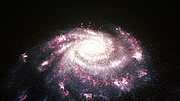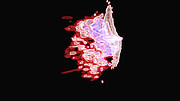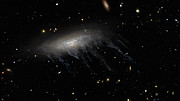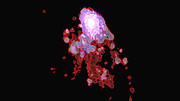Example of a jellyfish galaxy
Example of a jellyfish galaxy
Visualisation of MUSE view of Jellyfish Galaxy
Example of a jellyfish galaxy
Videos
Videos

ESOcast 122 Light: Supermassive Black Holes Feed on Cosmic Jellyfish (4K UHD)
Visualisation of a galaxy undergoing ram pressure stripping
ESO’s MUSE instrument on the VLT discovers new way to fuel black holes
Observations of “Jellyfish galaxies” with ESO’s Very Large Telescope have revealed a previously unknown way to fuel supermassive black holes. It seems the mechanism that produces the tentacles of gas and newborn stars that give these galaxies their nickname also makes it possible for the gas to reach the central regions of the galaxies, feeding the black hole that lurks in each of them and causing it to shine brilliantly. The results appeared today in the journal Nature.
An Italian-led team of astronomers used the MUSE (Multi-Unit Spectroscopic Explorer) instrument on the Very Large Telescope (VLT) at ESO’s Paranal Observatory in Chile to study how gas can be stripped from galaxies. They focused on extreme examples of jellyfish galaxies
in nearby galaxy clusters, named after the remarkable long “tentacles”
of material that extend for tens of thousands of light-years beyond
their galactic discs [1][2].
The tentacles of jellyfish galaxies are produced in galaxy clusters by a process called ram pressure stripping.
Their mutual gravitational attraction causes galaxies to fall at high
speed into galaxy clusters, where they encounter a hot, dense gas which
acts like a powerful wind, forcing tails of gas out of the galaxy’s disc
and triggering starbursts within it.
Six out of the seven jellyfish galaxies in the study were found to host a supermassive black hole at the centre, feeding on the surrounding gas [3]. This fraction is unexpectedly high — among galaxies in general the fraction is less than one in ten.
“This strong link between ram pressure stripping and active black holes was not predicted and has never been reported before,” said team leader Bianca Poggianti from the INAF-Astronomical Observatory of Padova in Italy. “It seems that the central black hole is being fed because some of the gas, rather than being removed, reaches the galaxy centre.” [4]
A long-standing question is why only a small fraction of
supermassive black holes at the centres of galaxies are active.
Supermassive black holes are present in almost all galaxies, so why are
only a few accreting matter and shining brightly? These results reveal a
previously unknown mechanism by which the black holes can be fed.
Yara Jaffé, an ESO fellow who contributed to the paper explains the significance: “These
MUSE observations suggest a novel mechanism for gas to be funnelled
towards the black hole’s neighbourhood. This result is important because
it provides a new piece in the puzzle of the poorly understood
connections between supermassive black holes and their host galaxies.”
The current observations are part of a much more extensive study of many more jellyfish galaxies that is currently in progress.
“This survey, when completed, will reveal how many, and which,
gas-rich galaxies entering clusters go through a period of increased
activity at their cores,” concludes Poggianti. “A long-standing
puzzle in astronomy has been to understand how galaxies form and change
in our expanding and evolving Universe. Jellyfish galaxies are a key to
understanding galaxy evolution as they are galaxies caught in the
middle of a dramatic transformation.”
Notes
[1] To date, just over 400 candidate jellyfish galaxies have been found.
More Information
Contacts
Bianca Poggianti
INAF-Astronomical Observatory of Padova
Padova, Italy
Tel: +39 340 7448663
Email: bianca.poggianti@oapd.inaf.it
Notes
[1] To date, just over 400 candidate jellyfish galaxies have been found.
[2] The results were produced as part of the observational programme known as GASP (GAs Stripping Phenomena in galaxies with MUSE),
which is an ESO Large Programme aimed at studying where, how and why
gas can be removed from galaxies. GASP is obtaining deep, detailed MUSE
data for 114 galaxies in various environments, specifically targeting
jellyfish galaxies. Observations are currently in progress.
[3] It is well established
that almost every, if not every, galaxy hosts a supermassive black hole
at its centre, between a few million and a few billion times as massive
as our Sun. When a black hole pulls in matter from its surroundings, it
emits electromagnetic energy, giving rise to some of the most energetic
of astrophysical phenomena: active galactic nuclei (AGN).
[4] The team also
investigated the alternative explanation that the central AGN activity
contributes to stripping gas from the galaxies, but considered it less
likely. Inside the galaxy cluster, the jellyfish galaxies are located in
a zone where the hot, dense gas of the intergalactic medium is
particularly likely to create the galaxy’s long tentacles, reducing the
possibility that they are created by AGN activity. There is therefore
stronger evidence that ram pressure triggers the AGN and not vice versa.
More Information
This research was presented in a paper entitled “Ram
Pressure Feeding Supermassive Black Holes” by B. Poggianti et al., to
appear in the journal Nature on 17 August 2017.
The team is composed of B. Poggianti (INAF-Astronomical
Observatory of Padova, Italy), Y. Jaffé (ESO, Chile), A. Moretti
(INAF-Astronomical Observatory of Padova, Italy), M. Gullieuszik
(INAF-Astronomical Observatory of Padova, Italy), M. Radovich
(INAF-Astronomical Observatory of Padova, Italy), S. Tonnesen (Carnegie
Observatory, USA), J. Fritz (Instituto de Radioastronomía y Astrofísica,
Mexico), D. Bettoni (INAF-Astronomical Observatory of Padova, Italy),
B. Vulcani (University of Melbourne, Australia; INAF-Astronomical
Observatory of Padova, Italy), G. Fasano (INAF-Astronomical Observatory
of Padova, Italy), C. Bellhouse (University of Birmingham, UK; ESO,
Chile), G. Hau (ESO, Chile) and A. Omizzolo (Vatican Observatory,
Vatican City State).
ESO is the foremost intergovernmental astronomy
organisation in Europe and the world’s most productive ground-based
astronomical observatory by far. It is supported by 16 countries:
Austria, Belgium, Brazil, the Czech Republic, Denmark, France, Finland,
Germany, Italy, the Netherlands, Poland, Portugal, Spain, Sweden,
Switzerland and the United Kingdom, along with the host state of Chile.
ESO carries out an ambitious programme focused on the design,
construction and operation of powerful ground-based observing facilities
enabling astronomers to make important scientific discoveries. ESO also
plays a leading role in promoting and organising cooperation in
astronomical research. ESO operates three unique world-class observing
sites in Chile: La Silla, Paranal and Chajnantor. At Paranal, ESO
operates the Very Large Telescope and its world-leading Very Large
Telescope Interferometer as well as two survey telescopes, VISTA working
in the infrared and the visible-light VLT Survey Telescope. ESO is also
a major partner in two facilities on Chajnantor, APEX and ALMA, the
largest astronomical project in existence. And on Cerro Armazones, close
to Paranal, ESO is building the 39-metre Extremely Large Telescope, the
ELT, which will become “the world’s biggest eye on the sky”.
Links
Links
- Research paper in Nature
- Photos of the VLT
- Photos of MUSE
- Further details about the GASP (GAs Stripping Phenomena in galaxies with MUSE) programme
- Jellyfish galaxies 3D models: JW100, JO175, and JO194
Contacts
Bianca Poggianti
INAF-Astronomical Observatory of Padova
Padova, Italy
Tel: +39 340 7448663
Email: bianca.poggianti@oapd.inaf.it
Richard Hook
ESO Public Information Officer
Garching bei München, Germany
Tel: +49 89 3200 6655
Cell: +49 151 1537 3591






